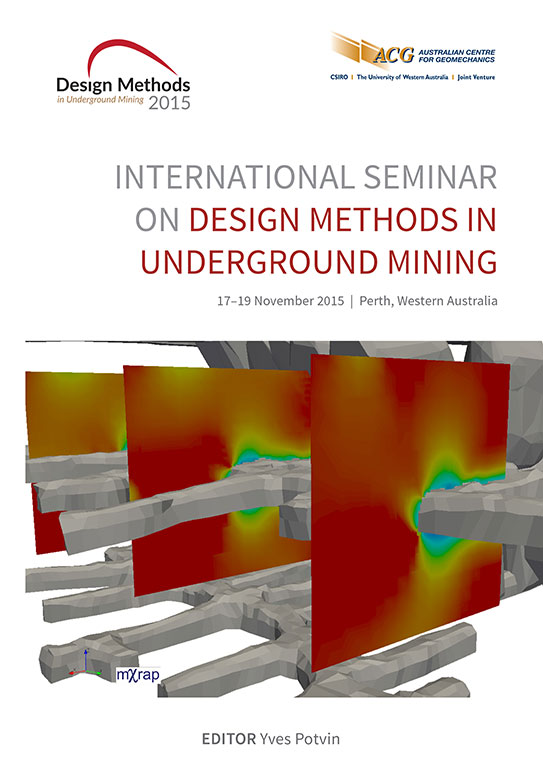Dugald River case study — the importance of understanding your orebody and designing your mine for maximum value

|
Authors: Harris, P |
DOI https://doi.org/10.36487/ACG_rep/1511_0.2_Harris
Cite As:
Harris, P 2015, 'Dugald River case study — the importance of understanding your orebody and designing your mine for maximum value', in Y Potvin (ed.), Design Methods 2015: Proceedings of the International Seminar on Design Methods in Underground Mining, Australian Centre for Geomechanics, Perth, pp. 21-36, https://doi.org/10.36487/ACG_rep/1511_0.2_Harris
Abstract:
The Dugald River Zn-Pb-Ag deposit was first discovered pre-1880, and is regarded as one of the largest and highest grade undeveloped deposits of zinc in the world with a mineral resource of 55 Mt at 13.4% zinc, 2.1% lead and 36 g/t silver. It was largely neglected until the 1950s, when systematic exploration was conducted; however, due to low base metal prices and the discovery and development of nearby deposits, the orebody remained undeveloped. Exploration decline development started in February 2012, providing early access to the orebody. Towards the end of 2012, exposure of the geological conditions in oredrive development and from underground diamond drilling highlighted a more complex and challenging mining environment than understood from the feasibility study. The Dugald River project was approved in December 2012, with a technical risk mitigation programme established to better understand the orebody characteristics and assess critical parameters related to the potentially more complex ground conditions and resulting dilution, stope sizes and general mineability. The technical risk mitigation programme concluded that ore variability was higher than expected and that ground conditions were likely to be worse than anticipated. Mine method and business options reviews were recommended to determine the path forward to fully maximise the value of the Dugald River deposit. The economic evaluation following these reviews illustrated the high sensitivity of mining and geotechnical design assumptions to mine production rate, plant feed grade and, ultimately, project value. As a result, the project was suspended in September 2013 to enable further investigation to determine mining and geotechnical design parameters and practical mine operating performance. A trial stoping programme and a geological and geotechnical work program were designed to significantly improve orebody knowledge and to derive mining and geotechnical design parameters that could be used to develop a revised mine design and mine production schedule with a much greater level of confidence. The programmes were highly successful in reducing technical risk and project uncertainty. The final result is a revised mine design with a 1.5 Mtpa production rate and an estimated 28 year mine life. Value engineering of the process plant and associated surface infrastructure to match the mine production rate have resulted in an updated development plan that fully maximises the long-term value of the Dugald River deposit. It is the purpose of this paper to explain in some detail the evolution in the technical understanding of the Dugald River deposit following its acquisition by MMG Limited. The advancement of technical knowledge not only led to a reduction in project risk and uncertainty, but also had significant impact on mine design and the project development plan.
References:
AMC Consultants 2008, Dugald River feasibility study geotechnical, external consultant report for MMG Limited.
AMC Consultants 2013, Dugald River mining methods review, external consultant report for MMG Limited.
Capes, G 2009, ‘Open stope hangingwall design based on general and detailed data collection in rock masses with unfavourable hangingwall conditions’, PhD thesis, University of Saskatchewan.
Hassell, R, de Vries, R, Player, J & Rajapakse, A 2015a, ‘Dugald river trial stoping, overall hangingwall behaviour’, in Y Potvin (ed.) Proceedings of the International Seminar on Design Methods in Underground Mining, Australian Centre for Geomechanics, Perth.
Hassell, R, Villaescusa, E, de Vries, R & Player, J 2015b, ‘Stope blast vibration analysis at the Dugald River underground mine’, Proceedings of the 11th International Symposium on Rock Fragmentation by Blasting (Fragblast 11), The Australasian Institute of Mining and Metallurgy, Melbourne.
MMG Limited 2009, Dugald River project feasibility study, internal report, MMG Limited, Melbourne.
MMG Limited 2013, Dugald River business options review report, internal report, MMG Limited, Melbourne.
MMG Limited 2015, Dugald River updated development plan report, internal report, MMG Limited, Melbourne.
© Copyright 2025, Australian Centre for Geomechanics (ACG), The University of Western Australia. All rights reserved.
View copyright/legal information
Please direct any queries or error reports to repository-acg@uwa.edu.au
View copyright/legal information
Please direct any queries or error reports to repository-acg@uwa.edu.au